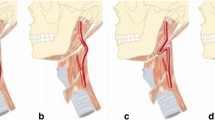Abstract
We present a case of a 71-year-old woman who was incidentally found to have aberrant retropharyngeal internal carotid artery, lying very close to the pharyngeal mucosa, on imaging. Radiologists, otolaryngologists and anaesthetists should be aware of this clinically significant variant which can result in life-threatening bleeding during procedures in the oral cavity or oropharynx.

Similar content being viewed by others
References
Fix TJ, Daffner RH, Deeb ZL (1996) Carotid transposition: another cause of wide retropharyngeal soft tissues. Am J Roentgenol 167:1305–1307
Galletti B, Bucolo S, Abbate G, Calabrese G, Romano G, Quattrocchi C, Freni F (2002) Internal carotid artery transposition as risk factor in pharyngeal surgery. Laryngoscope 112:1845–1848
Lo CC, Luo CM, Fang TJ (2010) Aberrant internal carotid artery in the mouth mimicking peritonsillar abscess. Am J Emerg Med 28:259, e5–6
Muñoz A, De Vergas J, Crespo J (2010) Imaging and clinical findings in patients with aberrant course of the cervical internal carotid arteries. Open Neuroimag J 4:174–181
Ozgur Z, Celik S, Govsa F et al (2007) A study of the course of the internal carotid artery in the parapharyngeal space and its clinical importance. Eur Arch Otorhinolaryngol 264:1483–1489
Paulsen F, Tillmann B, Christofides C et al (2000) Curving and looping of the internal carotid artery in relation to the pharynx: frequency, embryology and clinical implications. J Anat 197:373–381
Pfeiffer J, Ridder GJ (2008) A clinical classification system for aberrant internal carotid arteries. Laryngoscope 118:1931–1936
Shanley DJ (1992) Bilateral aberrant cervical internal carotid arteries. Neuroradiology 35:55–56
Tsuiki S, Isono S, Ishikawa T, Yamashiro Y, Tatsumi K, Nishino T (2008) Anatomical balance of the upper airway and obstructive sleep apnea. Anesthesiology 108:1009–1015
Windfuhr JP, Schloendorff G, Sesterhenn AM, Prescher A, Kremer B (2009) A devastating outcome after adenoidectomy and tonsillectomyideas for improved prevention and management. Otolaryngol Head Neck Surg 140:191–196
Conflict of interest
None.
Author information
Authors and Affiliations
Corresponding author
Rights and permissions
About this article
Cite this article
Srinivasan, S., Ali, S.Z. & Chwan, L.T. Aberrant retropharyngeal (submucosal) internal carotid artery: an under-recognized, clinically significant variant. Surg Radiol Anat 35, 449–450 (2013). https://doi.org/10.1007/s00276-012-1047-3
Received:
Accepted:
Published:
Issue Date:
DOI: https://doi.org/10.1007/s00276-012-1047-3




